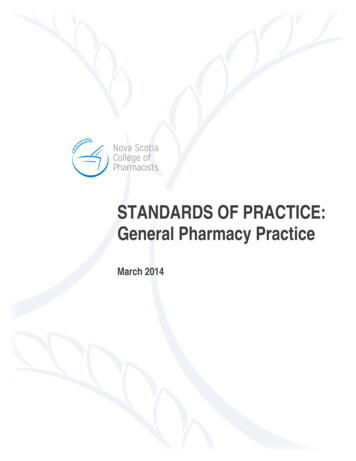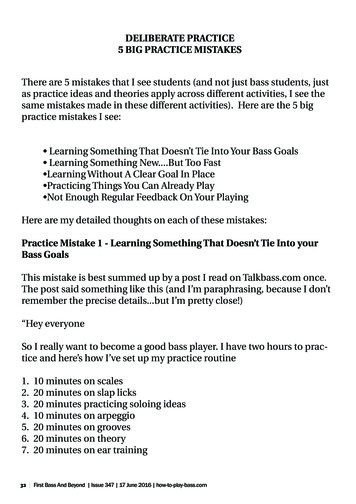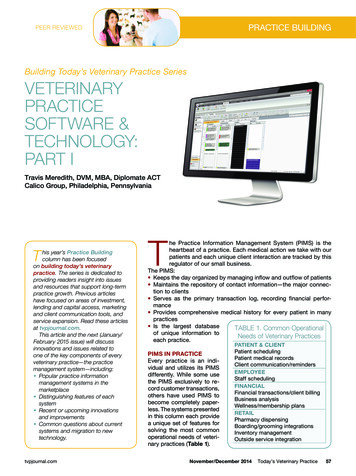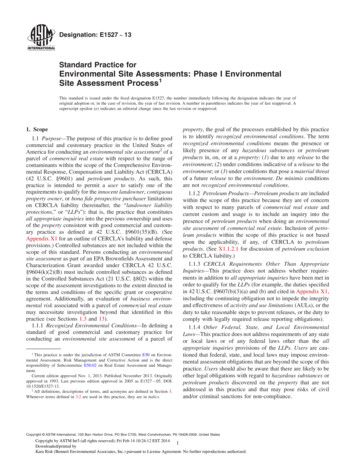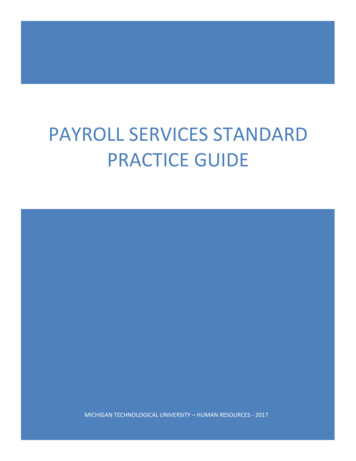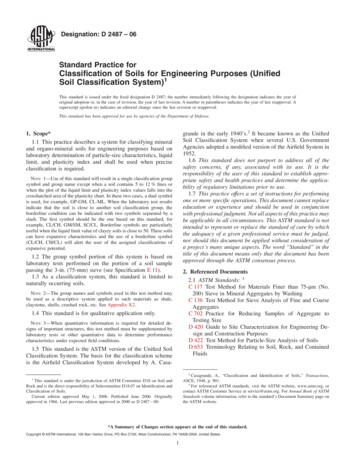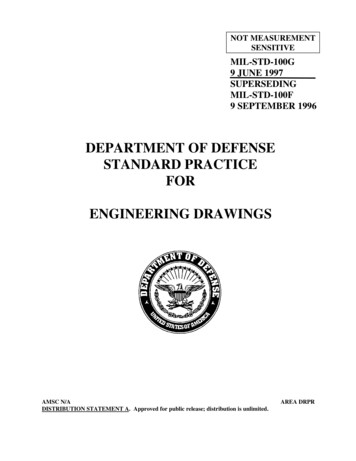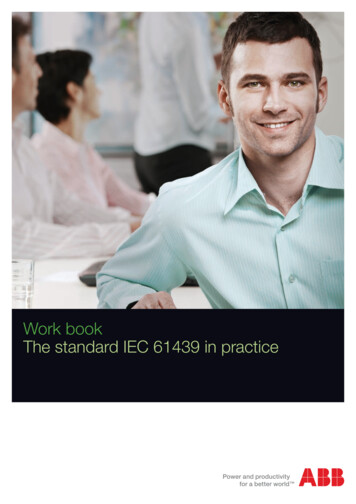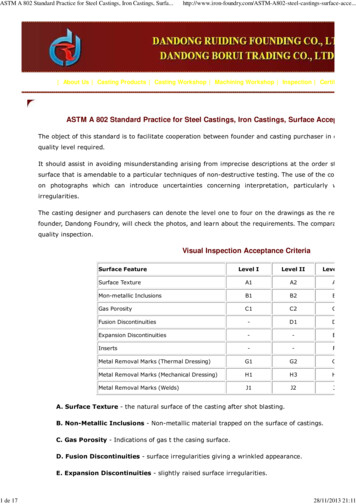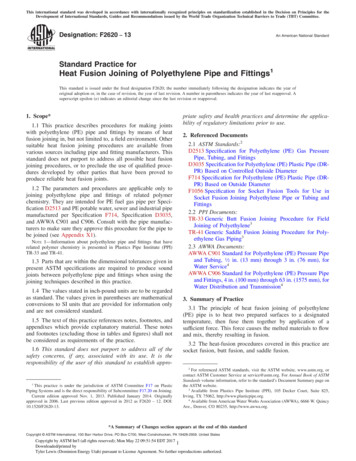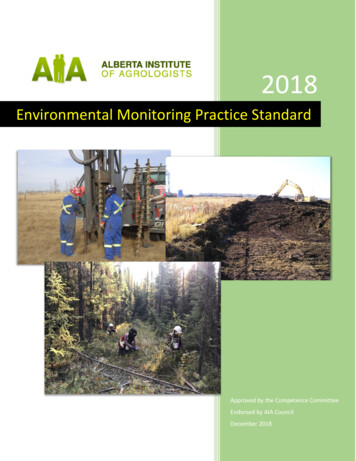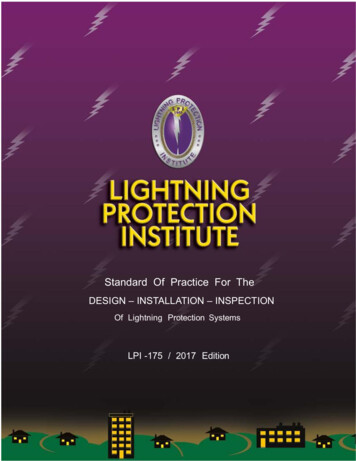
Transcription
Standard Of Practice For TheDESIGN – INSTALLATION – INSPECTION
Pages (Paragraphs)TABLE OF CONTENTS2 – 15SYSTEM OVERVIEWGENERAL REQUIREMENTSSYSTEM CERTIFICATIONINSPECTION & MAINTENANCE16(1 – 8)17 – 18(9 – 20)18(21 – 25)DEFINITIONS20 - 22MATERIALS23 – 25(26 – 50)STRIKE TERMINATION DEVICES25 – 35(51 – 79)MASTS & OVERHEAD CABLES35 – 37(80 – 88)ZONE OF PROTECTION38 – 40(89 – 99)MAIN CONDUCTORS41 – 44(100 – 110)DOWN CONDUCTORS44 – 46(111 – 122)GROUNDING46 – 51(123 – 142)INTERCONNECTION (BONDING)51 – 56(143 – 173)57 (174 – 179)CONCEALED SYSTEMSSTRUCTURAL METAL SYSTEMS57 – 59(180 – 187)SURGE PROTECTION59 – 61(188 – 212)ELEVATED STORAGE (SILOS)62 – 63(213 – 224)HEAVY DUTY STACKS63 – 66(225 – 248)TREE PROTECTION67 – 68(249 – 257)OPEN SHELTERS68 – 69(258 – 263)INDEX70 - 7273ABOUT LPI COPYRIGHT 2017: Lightning Protection Institute1
having jurisdiction over constructionprojects.System OverviewGeneral Industry InformationThe Lightning Protection Institute is anationwide not-for-profit organizationfounded in 1955 to promote lightningprotection education, awareness, and safety.The lightning protection industry began inthe United States when Benjamin Franklinpostulated that lightning was electricity, anda metal rod could be used to carry thelightning away from a building. Lightningis the direct cause of over 50 deaths and 400injuries each year, and it is difficult toprotect individuals in exposed outdoor areas.Direct lightning strikes cause fire damage inexcess of 200 million per year, andinsurance companies pay claims in thebillions of dollars associated with lightningeither directly or indirectly. Most of theseproperty losses could be minimized, if noteliminated, through the implementation ofproper lightning protection for structures.LPI is dedicated to ensuring that today’slightning protection systems provide the bestpossible quality in both materials andinstallation practices for maximum safety.The lightning protection Standard # 780 isreviewed on a three-year cycle for updating.NFPA 780 includes lightning protection fortypical building construction in Chapter 4 asgeneral requirements for structures. The780 document covers many specialtyconstructions from hazardous materialsstorage to boats and ships to open picnicstructures, and gives recommendations forpersonal safety outdoors. NFPA 780provides the best we know today in theoryand technology on protection systems testedby experienced industry professionals in alegally recognized format.Product testing for lightning protectionmaterial components in the factory prior toshipment for listing and labeling is handledby Underwriters Laboratories, Inc. (UL).The UL Standard 96 addresses the minimumrequirements for construction of airterminals, cable conductors, fittings,connectors, and fasteners used in qualitylightning protection systems. UL hasinspection personnel who visit productionfacilities on a regular basis to verifycompliance for continued use of theirapproved merchandise labels.The National Fire Protection Assoc.(NFPA) publishes document # 780 titledStandard for the Installation of LightningProtection Systems, an ANSI Standard,considered the national design guide forcomplete lightning protection systems in theUnited States. NFPA published its firstdocument on lightning protection in 1904.Similar NFPA documents like the NationalElectrical Code (NEC – NFPA 70), NationalFuel Gas Code (NFPA 54), and UniformFire Code (NFPA 1) are developed by thecommittee process to review acceptance ofnew safety information on specific firerelated subjects, and the standards areavailable for adoption by local authoritiesField inspection of completed lightningprotection installations may also be arrangedwith UL through installing contractors listedin their program. UL has issued a “MasterLabel” product for systems fully compliantwith their Standard UL 96A for many years.Standard 96A is based on the general2
requirements of NFPA 780, but UL has aStandards Technical Panel (STP) to reviewthe requirements for a more inspectableformat which leads to some differences. ULwill also inspect to some other nationallyrecognized Standards (like NFPA 780) forfully compliant systems. Some partialconstructions may be available for fieldinspection under their “Letter of Findings”program.installation and a resource for futureinspection and maintenance of existingsystems.LPI has implemented an inspectionprogram for completed installations underthe name LPI-IP. LPI-IP provides acertification service more thorough andcomplete than any previous inspectionprogram from LPI or others currentlyavailable in the marketplace. Through theuse of check points, reviews, and on-siteinspections, LPI-IP system certificationensures safety using qualified installerpersonnel and independent NationallyRecognized Testing Laboratory (NRTL)inspectors. LPI-IP offers a “MasterInstallation Certificate” for completestructures, a “Reconditioned MasterInstallation Certificate” for previouslycertified constructions, and a “LimitedScope Inspection” for partial systems indesignated contracts. This is a criticalelement to the specifier, owner, and propertyinsurer providing verification by a thirdparty independent source of qualitylightning protection installations.The Lightning Protection Institute (LPI)adopts the latest edition of theNFPA 780 Standard as its referencedocument for system design. LPI advocatesuse of UL as the third-party inspectionauthority for components according to theirdocument UL 96. LPI publishes thisdocument # 175 and Inspection Guide LPI#177, based on NFPA 780, with additionalexplanatory material helpful to installer andinspector member personnel.Lightning protection systems for structuresare typically not a requirement of nationalbuilding codes, although the Standards maybe adopted by the authority havingjurisdiction for general construction orspecific occupancies. Since lightningprotection may be considered an option, it iscrucial that the specifier, constructioncontractor, and property insurer be familiarwith the national Standards to provide thehighest level of safety available. Lightningprotection systems have a remarkablerecord of protecting against physical dangerto people, structural damage to buildings,and failure of internal systems andequipment. The value received begins withproper design, continues through qualityinstallation practices, and must includeLPI provides the industry self-policingtesting program for Journeyman, MasterInstaller, and Designer InspectorCertification of members. Individuals sit forexams which include the requirements of theabove listed lightning protection Standardsand application of those principles to designexamples. Membership renewal is requiredeach year with additional examinationstaken approximately every three years whenthe national Standards are updated.Contracting with professionals qualifiedthrough the LPI process ensures an addedlevel of quality assurance for initial system3
inspection and certification. The ultimategoal is safe haven, security of investment,and elimination of potential systemdowntime in opposition to one of nature’smost destructive events.strike terminations at the top and thegrounding electrode system at the bottom.General System InformationThe Standards in the United States forcomplete lightning protection systemsinclude NFPA 780, UL 96 & 96A, and LPI175 & 177. These Standards are based onthe fundamental principle of providing areasonably direct, low-resistance, lowimpedance metallic path for lightningcurrent to follow, and making provisions toprevent destruction, fire, damage, death, orinjury as the current flows from the rooflevels to below grade. The Standardsrepresent a consensus of authoritiesregarding basic requirements forconstruction and performance of qualifieddesigns and products. Based on soundengineering principles, research, records oftests and field experience, a completeprotection system is expected to createpersonal and structural safety from lightningand its secondary effects. The Standards areunder continuous review for new products,construction techniques, and validatedscientific developments to address thelightning hazard. Although materialcomponents may appear very similar, theconfiguration of a total system design haschanged dramatically over the last 25 yearsto reflect today’s lifestyles.The below grade grounding electrodesystem must efficiently move the lightningto its final destination away from thestructure and its contents. Bonding or theinterconnection of the lightning protectionsystem to other internal grounded metallicsystems must be accommodated to eliminatethe opportunity for lightning to sideflashinternally. Finally surge protection devicesmust be installed at every service entrance tostop the intrusion of lightning from utilitylines, and further equalize potential betweengrounded systems during lightning events.When these elements are identified properlyin the design stage, incorporated into a neatworkmanlike installation, and no changes tothe building occur, the system will protectagainst lightning damage. Elements of thispassive grounding system always serve asimilar function, but the total design isspecific for each particular structure.There are five elements that need to be inplace to provide an effective lightningprotection system. Strike terminationdevices must be suitable to accept directlightning attachment and patterned to acceptstrikes before they reach insulated buildingmaterials. Cable conductors routelightning current over and through theconstruction, without damage, betweenLightning protection components are madefrom materials that are resistant tocorrosion and they must be protected fromaccelerated deterioration. Many systemcomponents will be exposed to theatmosphere and climate. Combinations ofmaterials that form electrolytic couples in4
the presence of moisture shall not be used.Current carrying system components mustbe highly conductive. Prevailing site soilconditions will impact in-ground systemcomponents. The system life andmaintenance/replacement cycle is dependenton material choice and the localenvironment. System materials must becoordinated with the structural materials inuse – including flashings, copings, ventilatorhousings, various roofing systems – tomaintain the moisture envelope for theintended life of the building.components for required transitions fromaluminum to copper. These may includelisted products for the purpose, or in somecases stainless steel components. Aluminumcan never come in contact with the earth orsoil. Aluminum should never contactalkaline based paint surfaces or beembedded directly in concrete.If any product is subject to unusualmechanical damage or displacement, it maybe protected with a molding or covering, butcare must be exercised to allow striketerminations and other roof mountedcomponents to serve their function inaccepting attachments. Lightning protectioncomponents below the strike terminals maybe concealed within the building below theroof level during construction or whenaccessible. The speed of lightning currentand splitting the flow among multiple pathswill not permit components to heat to anyinstantaneous ignition temperaturehazardous to typical building materials.Incorporating the system into theconstruction allows interconnection ofstructural metal framing and internalgrounded systems, and provides protectionagainst displacement and maintenance issueswhich are beneficial in extending the life ofa system.Copper, copper alloys (including brassand bronze), and aluminum are the basicsystem component materials. They servethe best combination of function for currentcarrying and weathering. Since aluminummaterials have slightly lower currentcarrying capability and mechanical strengththan similar sized copper products, listedand labeled materials for lightningprotection include larger physical size parts.For example to be considered equivalent, aminimum size air terminal would be ½”diameter in aluminum, versus 3/8” diameterin copper.Materials suitable for use in lightningprotection systems are listed, labeled, andtested according to UL Standard 96.Consideration for conductor design includesmaximizing surface area to carry lightningand flexibility of the configuration to makebends and turns required in installationpractices. Air terminal bases efficientlyaccomplish the transfer of a strike fromtermination device to cable conductor andsecurely mount to various building surfacesunder severe weather conditions. Splicingfittings must maintain contact withconductor lengths adequate to accomplishWater running off copper will oxidizealuminum and galvanized surfaces, socoordination of system design must includegalvanic considerations for potentialmounting problems. Qualified bimetallicfittings are used to coordinate system5
current transfer and weather the exposedenvironment. Grounding electrodes mustprovide the proper earth contact to dispersethe charge and satisfy requirements for lifecycle suitability in various soilcompositions. Bonding devices are sized toprovide adequate interconnection of systemsto create potential equalization throughoutthe structure. Surge Protection Devices arequalified at higher current levels to meet theneeds associated with lightning attachments.relatively balanced ion distribution. Whenwe raise a building into the air, a tree oreven a person to a lesser extent, we changethat electrical balance. The electrical fieldaccumulates to change points in thegeometry of ground mounted objects. Itemslike ridges and particularly ridge ends, edgesof flat roofed buildings and even more thecorners become points of accumulation forions that increase susceptibility to lightningattachments. A proper system of striketermination devices accounts for theserealities by using air terminals in aconfigured pattern designed to use thebuilding’s points of natural ionicaccumulation to pull lightning into theprotection system. The taller the structureand
NFPA 780 Standard as its reference document for system design. LPI advocates use of UL as the third-party inspection authority for components according to their document UL 96. LPI publishes this document # 175 and Inspection Guide LPI #177, based on NFPA 780, with additional explanatory material helpful to installer and inspector member personnel. LPI provides the industry self-policing .
